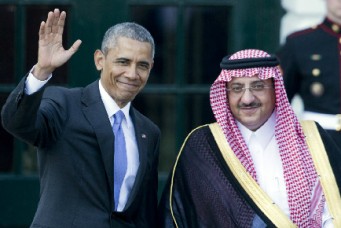Political Narratives in the Middle East and North Africa: Conceptions of Order and Perceptions of Instability
The volume edited by Wolfgang Mühlberger and Toni Alaranta highlights the importance of political narratives in making sense of the complexities of the MENA countries.


As part of Springer’s series on “Perspectives on Development in the Middle East and North Africa (MENA) Region”, this edited volume focuses on the importance of political narratives in making sense of the complexities of the MENA countries. The volume addresses this subject from a cross-disciplinary perspective utilizing linguistics, political science, International Relations (IR), and comparative Middle Eastern studies. From Christina Lin’s chapter in the volume, narratives are defined as “compelling story lines which can explain events convincingly from which inferences can be drawn” (Freedman 2006). She further explains that: “Strategic narratives, or stories with a political purpose used by actors to affect the behavior of others, may thus have a major impact on the international order.” Given that the MENA region is often seen as a problematic, conflict-ridden area of the world, narratives at the local, regional, and global levels compete to explain the sources of problems and conflicts in the region in order to mobilize support for particular collective action and/or policy responses.
The editors have organized the volume with an introduction that provides the conceptual framework for the substantive chapters, which are divided into two parts—Part I: Non-State Actors and Regional Powers: Narrating and Reshaping Order and Part II: Global Players’ Narratives Towards MENA Instability—and then ending with a concluding chapter. Part I of the volume focuses on local and regional actors in the MENA region, namely narratives of Hezbollah activists over the decision to send fighters to Syria, the clash between Israeli and Palestinian metanarratives, competing narratives influencing Turkey’s foreign policy in the region; and the role of narratives in the rivalry between Iran and Saudi Arabia in establishing hegemony in this area of the world, leading to division in the Gulf Cooperation Council (GCC). Part II of the volume focuses on the narratives of the following global actors who have strategic interests in the region: Russia, China, the United States, and the European Union.
Every chapter in this volume is strong. Even though the focus of the volume is on the MENA region post-Arab Spring, current narratives have histories. Each contributor provides empirical evidence in the form of key historical events and material conditions as the context for how narratives emerge, disappear, reappear, and transform over time as well as how competing narratives struggle for hegemony at the local, regional and global levels. The chapter on Hezbollah militants’ narratives’ contribution is that it gives voice to the party activists (“ordinary people”) instead of party elites. The author, Erminia Chiara Calabrese, shows the variation in narratives among activists in regards to Hezbollah’s decision to send fighters to Syria to support the Al-Assad regime, with some activists expressing distress that Hezbollah had become involved in the affairs of another country instead of focusing on protecting Lebanon. Moreover, the chapter demonstrates how activists adjusted their narratives over time to accept Hezbollah’s involvement in the Syrian civil war. The party leadership was able to convince activists that Hezbollah’s intervention was needed to prevent Syria’s civil war from spilling into Lebanon as well as to prevent a pro-Western/pro-Israeli government being installed in Syria, both of which would threaten the Lebanese Shia community.
The strength of the chapter on the clash of Israeli and Palestinian narratives is its demonstration of the power of narratives to constrain groups in conflict into entrenched positions. As the author, Olli Ruohomäki, explains: “The Palestinian metanarrative describes a people unjustly deprived of its land by invaders. The Israeli metanarrative, on the other hand, depicts the justified return of a historically dispossessed diaspora to the land of its ancestors. There is little understanding, respect or acknowledgement of what the other side perceives to be its narrative”. After detailing the development of the metanarratives and how they have influenced the policies and practices of the respective parties, the conclusion argues that as a first step to ending the impasse in the Israeli/Palestinian case requires that each side become “…acquainted with, respect and acknowledge each other’s metanarratives”.
The chapter on Turkey’s contribution highlights how competing narratives at the national level gain hegemony. Its focus is on “…the political narrative used for rationalizing, explaining and justifying Turkey’s foreign-policy behavior in the post-2011 Middle East”. The chapter’s author, Toni Alarenta, goes on to explain the historical context of how domestic factors influenced long term foreign policy traditions. Since the founding of the Turkish republic, there have been two competing significant “strategic culture traditions” that have influenced foreign policy, the Republican and the Imperial. The Republican tradition is rooted in the secular-nationalist Kemalist modernization project, which advocated that religion should not be a key part of Turkey’s national and state identity. In terms of foreign policy, this tradition promoted national sovereignty and argued against external interference in a country’s internal conflicts. In contrast, the Imperial tradition that emerged in the 1950s is “…explicitly grounded on historical-civilizational assumptions that religious identification plays a major if not the leading role in the life of a political community”. Since 2002, the current ruling regime, the Justice and Development Party (AKP), has drawn on the latter narrative tradition to justify its aspirations for Turkey becoming a regional power post-Cold War. More recently, the Imperial tradition has been used to justify the AKP government’s interventionist post-2011 Middle East policy, especially in Syria but also in Libya, Egypt, and Iraq. The AKP saw the Arab uprisings as an opportunity for Turkey to provide order to the region by creating a foreign policy narrative that mainly targets “…Islamic-Conservative constituencies, traditionally represented by the Muslim Brotherhood movement…”. However, Alaranta concludes that the appeal of Turkey’s narrative justifying that it become a regional power will be limited by its “…domestic authoritarian system and interventionist foreign-policy behavior: it will at best able to appeal to certain Muslim Brotherhood constituencies in various Middle Eastern countries.”
The strength of the chapter on the Gulf is that it demonstrates how the competition between narratives at the regional level affect stability in the Gulf region. The author, Kristian Coates Ulrichsen, traces the post-2011 uprising situation back to 1979, the year of the Iranian revolution as well as Shia-led protests in the Eastern Province and the takeover of the Grand Mosque in Mecca by Sunni fundamentalists, which shook Saudi Arabia in November and December of 1979, respectively. As a result, Saudi government policy became more Islamized in an effort to reassert its position as the leader of Sunni Islam with Iran’s revolutionary government trying to do the same with Shia Islam, marking the beginning of their rivalry that was exacerbated by the Iran/Iraq war in the 1980s. Then Coates Ulrichsen argues that “…the rise of sectarian identity politics in the region after the US-led invasion and occupation of Iraq in 2003…”, led to a prevalent security narrative that influenced how Gulf states dealt with each other. Security concerns increased for the Gulf due to the Arab uprisings and Syrian civil war that began in 2011 and the emergence of the Islamic State of Iraq and Syria (ISIS) in 2014. In this context, regime response to uprisings in Bahrain, Yemen, Kuwait, and parts of Oman and Saudi Arabia was to blame external forces—Iran in the case of Bahrain and Saudi Arabia and the Muslim Brotherhood in areas where Sunnis participated in protests—deflecting from the domestic causes of dissent in order to reestablish order. Moreover, the Iran/Saudi Arabia rivalry led them to take opposing sides in Yemen’s civil war, which has devastated the country; while Qatar’s support of the Muslim Brotherhood and uprisings in North Africa, and its economic and political relationship with Iran has put it in conflict with Saudi Arabia, the UAE and Bahrain. Since 2014, this conflict has come to a head twice which, Coates Ulrichsen argues, has “…created a new regional fault line that has triggered a new set of polarizing narratives and has undone four decades of cautious integration of the six Arab Gulf States within the GCC.” With the GCC’s inability to resolve the dispute, the lack of trust and severed ties between the conflicting parties could have serious security implications for years to come.
On the global level, Russia, China, the United States and the European Union have competing narratives for understanding and bringing stability to the region. While each chapter goes through the specific histories and developments for each of these actors’ narratives, I would summarize the narrative approaches into two main camps. On the one side, the US and EU subscribe to the “liberal international order” narrative which supports democracy promotion, human rights, and market liberalization while still protecting Western economic and security interests. This has often led to contradictory policies (e.g. former U.S. President George W. Bush’s so-called Freedom Agenda) with disastrous results for the MENA region. On the other side, part of Russia and China’s narrative is critique that the “…Western democracy-promotion narrative is seen to undermine state sovereignty, create chaos, encourage violence, and promote deep-seated conceptions of double standards”. Instead this camp seeks to work with MENA regimes to build bilateral economic ties with the end result, they hope, being economic development, stability and peace. However, Alaranta argues in the conclusion of this volume that this approach:
…is constrained by a lack of emancipatory and utopian elements. In other words, they contain intellectually comforting elements in terms of avoiding increased violence and chaotic developments resulting from Western-led forced regime change. However, as long as the Middle Eastern states are deeply authoritarian and reluctant to allow even the most basic democratic rights, the conservative narratives advocated by Russia and China fail to provide an emotionally comforting vision of a more democratic future for the peoples of the Middle East.
In sum, I found this volume to provide an interesting and compelling argument on how narratives can shape understandings of order and instability in the region; as well as on the role of competing narratives at the local, regional, and global levels in further exacerbating conflict. I would recommend this book for international relations and comparative politics courses on the Middle East as a companion piece to political economy approaches to gain a fuller understanding of the region.
Helen Mary Rizzo is an associate professor of sociology and Unit Head of Sociology at the American University in Cairo, where she serves on the graduate advisory committee of the Cynthia Nelson Institute for Gender and Women’s Studies. Rizzo received her PhD in sociology from Ohio State University in 2000. Her book, Islam, Democracy and the Status of Women: The Case of Kuwait, was published in 2005 by Routledge Press. More recently, she has worked on a British Academy Small Grants funded project, titled Youth Perspectives on Gender Norms and Public Sexual Violence in Cairo: Cultural and Media Perspectives. She is also doing research on social movement campaigns against public space sexual harassment, and masculinities in Egypt.
Read More




